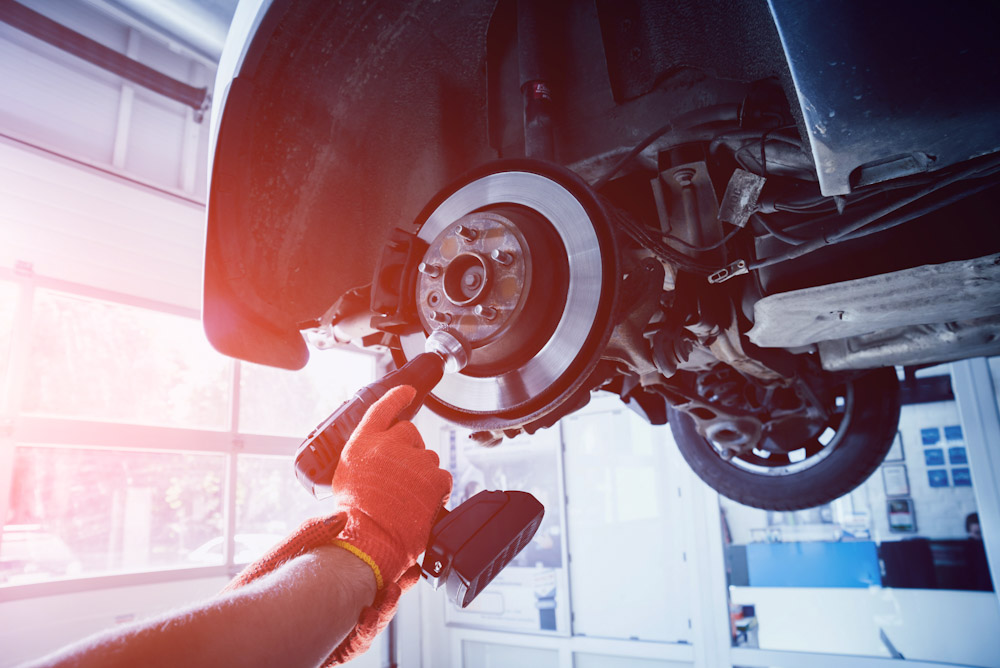
Just as important to the operation of a car is not only how it goes, but also how it stops. In fact, for those in an emergency situation on a busy street, very few things matter at that point apart from whether or not the car can stop. The development and innovation of a reliable braking system have been a priority for car manufacturers for over a hundred years, and for good reason; a study conducted recently has found that faulty brakes are leading to the deaths of 10 people or more every year, with the number of injured people settling around 600.
For this reason, it is crucial to have your brake system taken to an auto repair shop frequently to have the various parts tested and maintained. Becoming educated as to how the brake system is comprised, as well as what each individual component does will help you stay aware of any issues you may experience while driving. This will also help you describe accurately to your Master Muffler mechanic what your car’s problems have been.
The Braking System
The braking apparatus for your vehicle is a marvel of engineering, combining multiple types of input from the mechanical to the hydraulic, in order to exert enough force on the tires to stop them from spinning, even while they are going at a high rate of speed. Your brakes are composed of multiple components, including:
- Brake Pedal: The brake pedal is the initial input mechanism for the braking system, engaged by the driver. By pressing down on the pedal with their foot, the driver signals to the master cylinder to release brake fluid to the discs.
- Master Cylinder: When the brake pedal is pushed, it moves a piston housed in this cylinder, which then pushes brake fluid (housed in a reservoir not far away that is sending fluid into the cylinder) into the brake lines.
- Brake Lines: A system of tubes within the undercarriage of the vehicle that allows the brake fluid to travel the length of the car to the four slave cylinders.
- Slave Cylinder: There is a slave cylinder located at each tire with a piston of its own. As it fills with brake fluid, the piston exerts frictional pressure on a brake pad which arrests the inertia of the spinning wheels until they stop moving.
- Disc Brakes: The housing of the brake pad, usually located on the front tires. The back tire mechanisms are called Drum Brakes.
Maintaining the braking system is essential to keeping the occupants of the car safe, as well as everyone else on the road. The experts at Master Muffler in Sandy are extremely proficient in attending to the car repairs of a brake system and can help your car remain roadworthy.
Knowing It’s Time For An Auto Repair
It is unfeasible (not to mention unnecessary) to assume that a driver will bring their car into Master Muffler each month to check on the condition of the brakes. There are a few ways to check on the brakes independently without the need of a car repair expert.
- Ideally, check on the brake fluid levels once a quarter. The fluid reservoir will be located near the back of the engine block, and will usually have a translucent drum with a clearly marked “FULL” line.
- Brake pads and discs will begin to squeal and whine when getting near the end of their life cycle. You can certainly change them out before that happens, though﹘usually every 20,000 miles or so. You will also see cracks in the pad that show it’s time to replace them.
If you have any questions regarding the health of your brake system, feel free to drop by our Sandy Master Muffler and get a car repair appointment today.
Related Posts
As an EV owner, understanding your vehicle's battery is critical. From its capacity to its lifespan, and everything in between, we'll guide you through what you need to know to optimize your EV experience. So buckle up and get ready - we're about to shed some light on the electrifying world of EV batteries. What [...]
If your car is running hot, it can be a sign that something’s not right with your engine. Fortunately, diagnosing the cause of an overheating engine isn't too difficult if you know what to look for and how to address it. Keep reading if you want to learn the most common issues that occur when [...]
Your vehicle's exhaust system serves a critical role in managing the byproducts of the combustion process and ensuring optimal engine performance. The appearance of colored smoke from the exhaust pipe, either when stationary or accelerating, can provide valuable clues to underlying mechanical issues. What is a car exhaust? A car exhaust is a system [...]





